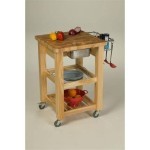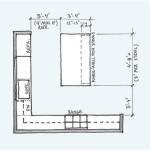What Is A Standard Kitchen Sink Size?
The kitchen sink is a fundamental component of any functional kitchen space. It serves as a central hub for food preparation, cleaning, and various other household tasks. Choosing the right sink size is crucial for optimizing workflow, maximizing space utilization, and ensuring overall kitchen efficiency. Defining a "standard" kitchen sink size, however, is not a simple matter, as dimensions vary widely based on sink type, bowl configuration, and intended use. This article provides a comprehensive overview of common kitchen sink sizes, exploring the factors that influence these dimensions and offering guidelines for selecting the appropriate sink for specific needs.
Understanding sink dimensions requires considering several key measurements. Length refers to the distance from the front to the back of the sink. Width represents the distance from side to side. Depth indicates the vertical distance from the top of the sink to the bottom of the bowl. These dimensions collectively determine the sink's overall volume and influence its suitability for handling various tasks, from washing small dishes to accommodating large pots and pans.
Furthermore, the type of sink significantly impacts its typical dimensions. Single-bowl sinks, double-bowl sinks, and farmhouse sinks, for example, all exhibit distinct size ranges. Material choice also plays a role, as certain materials may be more conducive to specific dimensions. Stainless steel, for instance, is commonly used for large sinks due to its durability and resistance to corrosion, while fireclay may have limitations in terms of available sizes.
Understanding Standard Single-Bowl Sink Sizes
Single-bowl sinks are characterized by a single, unobstructed basin. They are often favored for their simplicity and ease of use, particularly in smaller kitchens where space is limited. While there is no universally fixed "standard" size, certain dimensions are more prevalent than others.
Generally, single-bowl kitchen sinks range in width from 15 to 33 inches. The most common width is around 24 to 30 inches, providing ample space for washing dishes and handling food preparation tasks. Length typically ranges from 15 to 25 inches. The depth of a single-bowl sink can vary significantly, but a depth of 8 to 10 inches is generally considered adequate for most household needs. Deeper sinks are available, offering increased capacity for washing larger items, but they may also require more reaching and potentially strain on the user's back.
Smaller single-bowl sinks, measuring around 15 to 20 inches in width, are suitable for compact kitchens or bar areas. These sinks are often used as secondary sinks for rinsing vegetables or preparing drinks. Larger single-bowl sinks, exceeding 30 inches in width, are better suited for larger kitchens where substantial dishwashing and food preparation activities take place. These sinks can comfortably accommodate large pots, pans, and baking sheets.
When selecting a single-bowl sink, it is essential to consider the size of the base cabinet that will house the sink. The sink's width should be slightly less than the cabinet's interior width to allow for proper installation and support. Furthermore, the sink's depth should be considered in relation to the available space beneath the counter, ensuring that there is sufficient clearance for plumbing and other under-sink components.
Exploring Standard Double-Bowl Sink Sizes
Double-bowl sinks offer the advantage of having two separate basins, allowing for simultaneous tasks such as washing dishes in one bowl and rinsing them in the other. This configuration can enhance efficiency and convenience, particularly for households with frequent dishwashing needs. Double-bowl sinks also exhibit a range of sizes and configurations, with variations in bowl sizes and placement.
In general, double-bowl kitchen sinks range in width from 22 to 48 inches. The most common width is around 30 to 36 inches, providing adequate space for two separate bowls. The overall length of a double-bowl sink typically ranges from 16 to 22 inches. The depth of each bowl can vary, but a depth of 7 to 10 inches is generally considered sufficient for most tasks.
Double-bowl sinks are available in various configurations, including equal-sized bowls, unequal-sized bowls, and low-divide options. Equal-sized bowls provide two basins with the same dimensions, offering versatility for a range of tasks. Unequal-sized bowls feature one larger bowl and one smaller bowl, allowing for specialized use. The larger bowl may be used for washing dishes, while the smaller bowl may be used for rinsing vegetables or thawing meat.
Low-divide double-bowl sinks feature a divider between the two bowls that is lower than the top edge of the sink. This allows for easier handling of large items, such as pots and pans, while still providing the benefits of separate basins. The low divider can be particularly useful for users who frequently wash oversized items but still desire the functionality of a double-bowl sink.
When selecting a double-bowl sink, it is crucial to consider the size and configuration of the bowls in relation to the intended use. Households with frequent dishwashing needs may benefit from equal-sized bowls, while those who primarily use the sink for food preparation may prefer unequal-sized bowls with a larger primary basin. As with single-bowl sinks, the sink's width should be compatible with the size of the base cabinet, and the depth should be considered in relation to the available space beneath the counter.
Considering Farmhouse Sink (Apron-Front) Sizes
Farmhouse sinks, also known as apron-front sinks, are characterized by their exposed front panel, which extends slightly beyond the front edge of the countertop. This design element adds a distinctive visual appeal to the kitchen while also offering ergonomic advantages. Farmhouse sinks are typically larger and deeper than traditional sinks, accommodating larger pots and pans and reducing strain on the user's back.
Farmhouse sinks generally range in width from 24 to 60 inches. The most common width is around 30 to 36 inches, providing ample space for both washing and food preparation. The length of a farmhouse sink typically ranges from 20 to 28 inches. The depth of a farmhouse sink is generally greater than that of traditional sinks, ranging from 8 to 12 inches or even deeper. This increased depth allows for easier handling of large items and reduces the risk of water splashing onto the countertop.
Due to their larger size and distinctive design, farmhouse sinks require careful planning and installation. The base cabinet must be specifically designed to accommodate the sink's depth and front apron. The countertop must also be cut to fit the sink's shape, ensuring a seamless and watertight installation. It is often recommended to consult with a professional installer to ensure proper fit and functionality.
Farmhouse sinks are available in various materials, including fireclay, stainless steel, and cast iron. Fireclay is a popular choice for its durability and resistance to staining, while stainless steel offers a sleek and modern look. Cast iron provides a classic aesthetic and excellent heat retention. The choice of material will influence the sink's weight and installation requirements.
When selecting a farmhouse sink, it is essential to consider the overall style and design of the kitchen. Farmhouse sinks are often associated with traditional or rustic kitchens, but they can also be incorporated into more contemporary designs. The sink's size, material, and finish should complement the other elements of the kitchen, creating a cohesive and visually appealing space.
Beyond these standard types, other sink configurations exist, including corner sinks, which are designed to fit into the corner of a countertop, and prep sinks, which are smaller sinks typically used for food preparation tasks. The size and dimensions of these sinks vary widely depending on their intended use and placement.
Ultimately, selecting the appropriate kitchen sink size requires careful consideration of the available space, the intended use, and the overall design aesthetic of the kitchen. Understanding the typical dimensions of different sink types, as well as the factors that influence these dimensions, is crucial for making an informed decision. Consulting with a kitchen designer or plumbing professional can provide valuable guidance and ensure that the chosen sink is both functional and aesthetically pleasing.

What Are The Most Common Sink Sizes A Quartz

Standard Size One Bowl Kitchen Stainless Steel Sink 800 500mm Basin Water Tank Made In Com

Dc Distribution Quartz And Stone Countertop Fabrication Kitchen Bath Remodel Outdoor Kitchens Fire Tables Design Referrals Double Equal Bowls 18 Gauge Ss55 3318

American Standard Raviv Stainless Steel 33 In Single Bowl Drop Kitchen Sink 18sb000432c2 075 The Home

Double Bowl Kitchen Sinks Porcelain Looks With Cast Iron Strength

What Are The Most Common Sink Sizes A Quartz

Sink Fm Marine Kitchen Sinks

Types Of Kitchen Sinks The Home

Metric Data 09 Kitchen Standard Sizes

A Simple Guide To The Kitchen Sink Size Chica Dragon








